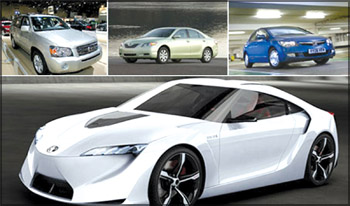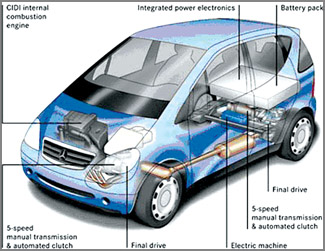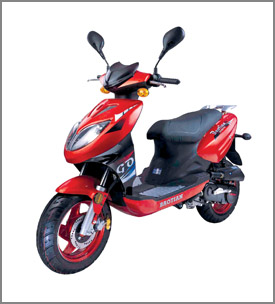 Hybrids Hybrids
Vehicles of the future:
Fuel prices are up
again and all indications are that they will increase even for the. This
must be an issue that worries your mum and dad. When the fuel price goes
up, prices of all other goods and services that are related to transport
go up. So, automatically, the cost of living goes up.
Is there a solution for this? Of course, at least to some extent,
where the fuel issue is concerned.

To beat the problem of fuel, scientists have invented hybrid cars.
What is a hybrid car? A hybrid vehicle (HV) uses two or more different
power sources to drive the vehicle, such as: an on-board rechargeable
energy storage system (RESS) and a fuelled power source (internal
combustion engine or fuel cell) for vehicle driving force.
It is also called a bi-energy vehicle. The hybrid vehicle typically
achieves greater fuel economy and lower emissions than standard internal
combustion engine vehicles (ICEVs), resulting in fewer emissions being
generated. These savings are primarily achieved by four elements of a
typical hybrid design:
1) Bringing back energy normally wasted during braking;
2) Having significant battery storage capacity to store and reuse
brought back energy;
3) Shutting down the gasoline or diesel engine during traffic stops
or while coasting or other idle periods;
4) Relying on both the gasoline (or diesel engine) and the electric
motors for peak power needs,
 resulting
in a smaller gasoline or diesel engine sized more for average usage
rather than peak power usage. resulting
in a smaller gasoline or diesel engine sized more for average usage
rather than peak power usage.
These features make a hybrid vehicle particularly efficient for city
traffic, where there are frequent stops and idling periods. In addition
to this, noise emissions are reduced, particularly at idling and low
operating speeds, in comparison to usual gasoline or diesel-powered
engine vehicles.
For continuous high speed highway use, these features are much less
useful in reducing emissions. Vehicles which have significant idle
periods and only occasional needs of peak power like railroad switching
trains or repeated lifting and lowering cycles like rubber tyred gantrys
are also good candidates for hybrid systems resulting in potentially
significant fuel and emission savings.
How a hybrid vehicle works
Basically, a hybrid electric vehicle (HEV) combines an internal
combustion engine and an electric motor powered by batteries, mixing the
best features of today's combustion engine cars and electric vehicles.
The combination allows the electric motor and batteries to help the
standard engine operate more efficiently, cutting down on fuel use.
Meanwhile, the gasoline-fuelled combustion engine overcomes the limited
driving range of an electric vehicle.
In the end, this hybridisation gives you the ability to drive 500
miles or more using less fuel and never having to plug in for
recharging.
Gasoline-fuelled HEVs are among a select few vehicle technologies
that can provide dramatically increased fuel economy and extremely low
levels of smog-forming and cancer-causing emissions, while delivering
the safety and performance the public has come to expect.
But that all depends on how well automakers apply the technology.
When looking at hybrids, no matter what the technology is the clearest
and most direct way to evaluate the environmental performance is by its
fuel economy and emissions.
Not all hybrids are created equal. Actually, there are degrees of
hybridisation such as 'mild' and 'full' and even different drive trains
utilised depending on which hybrid you're looking at.
|

Moped |
If we approach hybrids by looking at five technology steps that
separate conventional vehicles from battery electric vehicles, we can
better evaluate how a particular hybrid operates. To be a true hybrid, a
vehicle needs the first three steps. The fourth and fifth create the
potential for hybrids with superior energy and environmental
performance.
5 steps to hybridisation Idle-off
capability
Regenerative braking capacity
Power assist and engine downsizing (at this step you reach a "mild"
hybrid) Electric-only drive (at this step you reach a "full" hybrid)
Extended battery-electric range (at this step you become a "plug-in"
hybrid) So, next time your parents are looking around to buy a vehicle,
insist them to buy an environmental-friendly and economical hybrid
vehicle.
Compiled by Janani Amarasekara |

